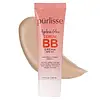What's inside
What's inside
 Key Ingredients
Key Ingredients

 Benefits
Benefits

 Concerns
Concerns

 Ingredients Side-by-side
Ingredients Side-by-side

Water
Skin ConditioningAlcohol Denat.
AntimicrobialDiisopropyl Sebacate
EmollientSilica
AbrasiveIsopropyl Myristate
EmollientEthylhexyl Salicylate
UV AbsorberEthylhexyl Triazone
UV AbsorberBis-Ethylhexyloxyphenol Methoxyphenyl Triazine
Skin ConditioningButyl Methoxydibenzoylmethane
UV AbsorberGlycerin
HumectantC12-22 Alkyl Acrylate/Hydroxyethylacrylate Copolymer
StabilisingPropanediol
SolventDrometrizole Trisiloxane
UV AbsorberCI 77891
Cosmetic ColorantPerlite
AbsorbentTocopherol
AntioxidantCaprylic/Capric Triglyceride
MaskingAcrylates/C10-30 Alkyl Acrylate Crosspolymer
Emulsion StabilisingCaprylyl Glycol
EmollientCI 77491
Cosmetic ColorantCI 77492
Cosmetic ColorantCI 77499
Cosmetic ColorantHydroxyethylcellulose
Emulsion StabilisingTerephthalylidene Dicamphor Sulfonic Acid
UV AbsorberTriethanolamine
BufferingTrisodium Ethylenediamine Disuccinate
Parfum
MaskingWater, Alcohol Denat., Diisopropyl Sebacate, Silica, Isopropyl Myristate, Ethylhexyl Salicylate, Ethylhexyl Triazone, Bis-Ethylhexyloxyphenol Methoxyphenyl Triazine, Butyl Methoxydibenzoylmethane, Glycerin, C12-22 Alkyl Acrylate/Hydroxyethylacrylate Copolymer, Propanediol, Drometrizole Trisiloxane, CI 77891, Perlite, Tocopherol, Caprylic/Capric Triglyceride, Acrylates/C10-30 Alkyl Acrylate Crosspolymer, Caprylyl Glycol, CI 77491, CI 77492, CI 77499, Hydroxyethylcellulose, Terephthalylidene Dicamphor Sulfonic Acid, Triethanolamine, Trisodium Ethylenediamine Disuccinate, Parfum
Bakuchiol
AntimicrobialAscorbic Acid
AntioxidantHyaluronic Acid
HumectantWater
Skin ConditioningHomosalate
Skin ConditioningIsotridecyl Isononanoate
EmollientZinc Oxide
Cosmetic ColorantDiphenylsiloxy Phenyl Trimethicone
Skin ConditioningTitanium Dioxide
Cosmetic ColorantCI 77492
Cosmetic ColorantButylene Glycol
HumectantCetyl PEG/PPG-10/1 Dimethicone
EmulsifyingPropylene Glycol Dicaprylate/Dicaprate
EmollientCaprylic/Capric Triglyceride
MaskingSorbitan Sesquioleate
EmulsifyingArbutin
AntioxidantSynthetic Beeswax
Emulsion StabilisingCI 77491
Cosmetic ColorantCI 77499
Cosmetic ColorantSodium Chloride
MaskingTribehenin
EmollientPolyglyceryl-3 Polyricinoleate
EmulsifyingStearalkonium Hectorite
Gel FormingPhenoxyethanol
PreservativeSorbitan Isostearate
EmulsifyingXanthan Gum
EmulsifyingEthylhexylglycerin
Skin ConditioningAdenosine
Skin ConditioningOlea Europaea Fruit Oil
MaskingCitrus Aurantium Bergamia Fruit Oil
MaskingLavandula Angustifolia Oil
MaskingCananga Odorata Flower Oil
MaskingCitrus Aurantium Dulcis Oil
MaskingCymbopogon Martini Oil
MaskingPelargonium Graveolens Flower Oil
MaskingTriethoxycaprylylsilane
Michelia Alba Flower Oil
MaskingEugenia Caryophyllus Leaf Oil
MaskingEucalyptus Globulus Leaf Oil
PerfumingTocopherol
AntioxidantJasminum Officinale Oil
Masking1,2-Hexanediol
Skin ConditioningBacillus Ferment
Skin ConditioningCornus Officinalis Fruit Extract
Skin ConditioningCrataegus Oxyacantha Fruit Extract
Skin ConditioningGardenia Jasminoides Fruit Extract
Cosmetic ColorantLycium Chinense Fruit Extract
AntioxidantSchisandra Chinensis Fruit Extract
Skin ConditioningLinalool
PerfumingLimonene
PerfumingBakuchiol, Ascorbic Acid, Hyaluronic Acid, Water, Homosalate, Isotridecyl Isononanoate, Zinc Oxide, Diphenylsiloxy Phenyl Trimethicone, Titanium Dioxide, CI 77492, Butylene Glycol, Cetyl PEG/PPG-10/1 Dimethicone, Propylene Glycol Dicaprylate/Dicaprate, Caprylic/Capric Triglyceride, Sorbitan Sesquioleate, Arbutin, Synthetic Beeswax, CI 77491, CI 77499, Sodium Chloride, Tribehenin, Polyglyceryl-3 Polyricinoleate, Stearalkonium Hectorite, Phenoxyethanol, Sorbitan Isostearate, Xanthan Gum, Ethylhexylglycerin, Adenosine, Olea Europaea Fruit Oil, Citrus Aurantium Bergamia Fruit Oil, Lavandula Angustifolia Oil, Cananga Odorata Flower Oil, Citrus Aurantium Dulcis Oil, Cymbopogon Martini Oil, Pelargonium Graveolens Flower Oil, Triethoxycaprylylsilane, Michelia Alba Flower Oil, Eugenia Caryophyllus Leaf Oil, Eucalyptus Globulus Leaf Oil, Tocopherol, Jasminum Officinale Oil, 1,2-Hexanediol, Bacillus Ferment, Cornus Officinalis Fruit Extract, Crataegus Oxyacantha Fruit Extract, Gardenia Jasminoides Fruit Extract, Lycium Chinense Fruit Extract, Schisandra Chinensis Fruit Extract, Linalool, Limonene
Ingredients Explained
These ingredients are found in both products.
Ingredients higher up in an ingredient list are typically present in a larger amount.
This ingredient is an emollient, solvent, and texture enhancer. It is considered a skin-softener by helping the skin prevent moisture loss.
It helps thicken a product's formula and makes it easier to spread by dissolving clumping compounds.
Caprylic Triglyceride is made by combining glycerin with coconut oil, forming a clear liquid.
While there is an assumption Caprylic Triglyceride can clog pores due to it being derived from coconut oil, there is no research supporting this.
Learn more about Caprylic/Capric TriglycerideCi 77491 is also hydrated iron III oxide. It's sole purpose is to give a red/pink hue to products.
Iron III oxides are classified as inorganic chemicals for coloring.
Synthetically created Ci 77491 is considered safer than those naturally found. This is because the synthetically created version may contain less impurities. Iron oxides are generally non-toxic and non-allergenic.
Learn more about CI 77491Ci 77492 is also hydrated iron III oxide. It's sole purpose is to give a yellow hue to products.
Iron III oxides are classified as inorganic chemicals for coloring.
Synthetically created Ci 77492 is considered safer than those naturally found. This is because the synthetically created version may contain less impurities. Iron oxides are generally non-toxic and non-allergenic.
Learn more about CI 77492Ci 77499 is also hydrated iron III oxide. It is created from mixing red and black iron oxides. This helps give shades of darkness to a product.
Iron III oxides are classified as inorganic chemicals for coloring.
Tocopherol (also known as Vitamin E) is a common antioxidant used to help protect the skin from free-radicals and strengthen the skin barrier. It's also fat soluble - this means our skin is great at absorbing it.
Vitamin E also helps keep your natural skin lipids healthy. Your lipid skin barrier naturally consists of lipids, ceramides, and fatty acids. Vitamin E offers extra protection for your skin’s lipid barrier, keeping your skin healthy and nourished.
Another benefit is a bit of UV protection. Vitamin E helps reduce the damage caused by UVB rays. (It should not replace your sunscreen). Combining it with Vitamin C can decrease sunburned cells and hyperpigmentation after UV exposure.
You might have noticed Vitamin E + C often paired together. This is because it is great at stabilizing Vitamin C. Using the two together helps increase the effectiveness of both ingredients.
There are often claims that Vitamin E can reduce/prevent scarring, but these claims haven't been confirmed by scientific research.
Learn more about TocopherolWater. It's the most common cosmetic ingredient of all. You'll usually see it at the top of ingredient lists, meaning that it makes up the largest part of the product.
So why is it so popular? Water most often acts as a solvent - this means that it helps dissolve other ingredients into the formulation.
You'll also recognize water as that liquid we all need to stay alive. If you see this, drink a glass of water. Stay hydrated!
Learn more about Water